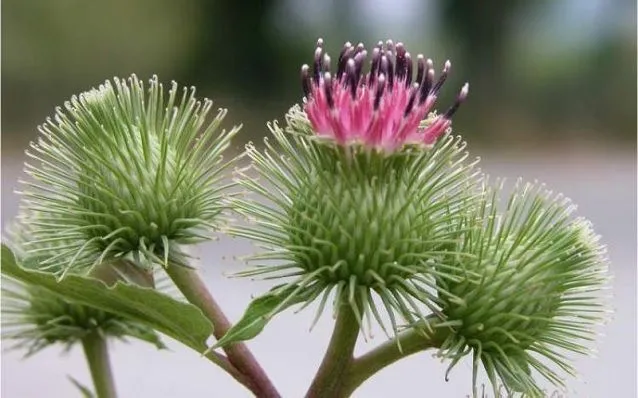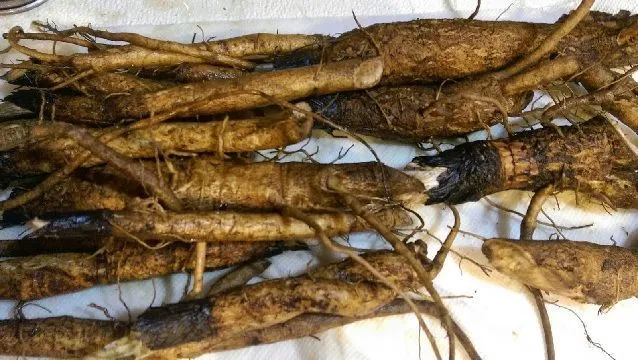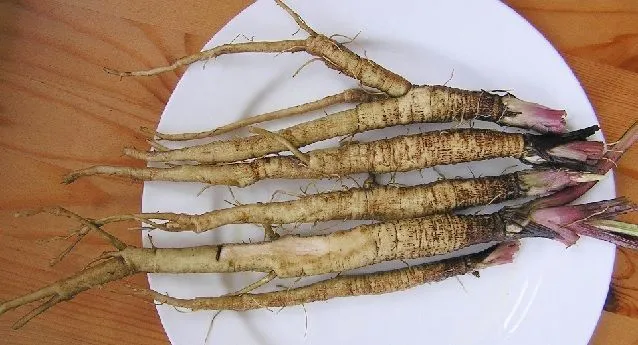Its scientific name is Arctium lappa, but is commonly known as burdock. It is a medicinal plant to which many medicinal properties are attributed that today are being studied.
It belongs to the family of Asteraceae, which in turn groups a large compendium of species that also have medicinal uses.
Burdock is a herbaceous plant that takes almost 2 years to complete its cycle. It has a very characteristic violet flowering similar to that of thistle. Its leaves, of vivid green color and circular appearance, come to have a large size.
In fact, you can see on the net a large number of images where you get to see exaggeratedly large leaves.
However, the medicinal properties of burdock it is not found there but in the rootworms, which contain a large number of active ingredients that we will list later.

Table of Contents
Getting to know the burdock a little more
Its origin is spread over different continents. The beginnings of burdock have always been attributed to Europe and Asia, especially in warm and temperate areas.
In the traditional Chinese medicine burdock roots have always been present. This has led to interesting studies on its potential as a medicinal plant being initiated in different universities and medical centers.
In fact, since the seventeenth century great interest has been attributed to burdock remedies from England, through Nicholas Culpeper. Hence the first references to ulcer treatments.
Arctium lappa we can see it growing in a rustic way in meadows, roadsides and even in plots of cities.
Cultivation and care
Germination
Burdock can be grow using seeds, since it does not need special germination or stratification care. A mixture of 70-30 of commercial substrate and sand will be more than enough to get new burdock plants by seed.
The seeds are buried maximum 1/2 centimeter deep on wet substrate, covering the hole with more substrate. We will maintain the temperature between 18 and 25 ºC.
It is watered periodically to maintain a homogeneous level of humidity and within 2 to 3 weeks we will see the first cotyledons come out.
Temperature conditions
the transplant can be done in pots or in our garden. As a plant it is quite rustic and withstands cold conditions well. We will not have problems given its wide range of support
Soil, irrigation and fertilizer
It adapts to different soils, both clay and sandy. It does not need excessive moisture and it is better to reduce the contributions of irrigation if we are going to use burdock for its medicinal qualities. In this way, the concentration of the active ingredients will increase compared to continuously irrigated plants.
As for fertilizer, the simple periodic incorporation of organic matter will be enough to ensure proper flowering and continuous transport of its compounds to the root, which medicinally is the most interesting part.
Medicinal properties of burdock

At present, a large number of different compounds that may have medicinal use have been evaluated. Among them, the one that stands out the most is the inulin, consisting of a polysaccharide containing sugary chains.
However, we found many more interesting compounds for use in all known remedies.
Active ingredients
- Inulin (between 30 and 50% of the weight of the root)
- Phenolic acids (caffeic, chlorogenic, arctiine
- Sesquiterpene lactones
- Natural polyacetylenes
- Tannins (astringents)
- Plant phytosterols
- Polyinus, polyenes and other organic principles with antimicrobial capacity
- Vitamin C and B
- Polyenes and polyins
- Alcoholic acids (acetic, propionic and isovaleric)
- Phenolic acids
- Lignans
- Acetylene thiophene compounds
The union of all these principles gives burdock antibacterial, anti-inflammatory, antitumor, antifungal, antimutagenic, antioxidant, antipyretic, diuretic, and h properties.ipoglycemic agents.
Antitumor properties
Currently, research is still in progress to find a positive pattern in improving the quality of life in the face of breast cancer. It is still too early to have conclusive results.
Diabetes
Early research shows that introducing burdock root into the diet prevents the rise in blood glucose in people with diabetes.
Urinary tract infections
Positive results have been obtained in urinary problems such as cystitis, ureteritis, prostatitis and inflammation of the kidney.
This is because burdock favors the expulsion of urine and has antimicrobial activity, against infections of this type.
Prevention of the formation of kidney stones
By favoring urine and fluid outflow, it prevents the formation of calcium-rich deposits and the consequent appearance of kidney stones. Therefore, burdock is an effective remedy against fluid retention in all kinds of people.
High blood pressure
The effects of burdock root as a long-term treatment against hypertension are being studied, as it regulates the accumulation of fluids and provides potassium. It can be interesting as an alternative and complement to the antihypertensive drugs that currently exist.
Increased appetite
Burdock stimulates the production of bile and promotes the creation of appetite. It has antimicrobial activity, useful in the appearance of ulcers and other wounds, as well as favors digestion if it is included in the diet on a regular basis.
Dermatological problems
The burdock plant it also has a skin-enhancing effect when applied topically.
It has been used throughout the history of traditional medicine as a remedy against juvenile acne, eczema, burns, hives and dermatitis related to psoriasis.
Antimicrobial potential
The interaction between burdock and different genera of fungi is being studied, verifying good results against the development of athlete’s foot (genera Trychophytum, Epidermophyton), pityriasis (genus Malassezia), or the candida fungus.
Home Remedies
When it comes to taking advantage of the medicinal properties of burdock we have different alternatives.
It can be used as a complement in the preparation of culinary dishes, although the root can also be used for decoctions and infusions.
- You can prepare a infusion with one teaspoon of burdock root powder per cup of water. Add hot water and let stand for 5 minutes.
- This same infusion can be used topically using compresses to accelerate the healing of wounds, burns, reduce juvenile acne, etc.
- In the market there are different capsules with extract or powder of burdock. 500 mg/capsule, 4-6 capsules/day divided into 2-3 doses.
Culinary uses

Since the Middle Ages burdock has been used for culinary use. In different Asian countries, such as Japan (known as Gobo), China, Korea or Taiwan it is included in different dishes, mixed with the traditional pasta of the country.
The aerial part, specifically the flowers, are used, practically with the same use that is currently given to the thistle or the flower of the artichoke, with a very similar flavor.
The root contains a large amount of minerals such as potassium, calcium and magnesium, as well as a significant amount of fiber (6 grams/100g)
When testing, we can say that it has a mixed flavor between spicy and sweet, with a crunchy texture. That same texture makes it used in the preparation of Asian dishes such as miso, mixed with pork or even in tempura.
Burdock-based products
Contraindications
Pregnancy and lactation
The interactions you may have with pregnant women or breastfeeding children are currently unknown. It is recommended not to take until there are signs or studies.
Disorders Hemorrhagic– Burdock may delay blood clotting. Taking burdock may increase the risk of bleeding in people with bleeding disorders.
Allergy to family plants Asteraceae
Burdock belongs to the family of asteraceae, where cases of allergies have often occurred due to some common active ingredients in the family.
Diabetes:
There is evidence of burdock to lower blood sugar. However, it is mandatory to consult with the specialist doctor to know how to combine current drugs with the plant, so as not to avoid excessively reducing blood glucose and causing a major problem.
Surgery
It is a plant that contains active ingredients related to the reduction of blood clotting. Therefore, in the case of anticoagulant operations or during treatment, it is recommended to consult with a specialist beforehand.
